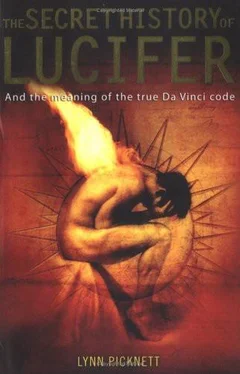Even before Guy Fawkes and his co-religionists attempted to blow up the Houses of Parliament," James had published his Daemonologie (1597), providing zealous witch-hunters with plentiful ammunition. In the book, the narrator Epistemon explains what categories of `unlawful charms, without natural causes' are to be considered witchcraft:
I mean by such kind of charms as commonly daft wives use, for healing of forspoken [bewitched] goods, for preserving them from evil eyes, by knitting ... sundry kinds of herbs to the hair of the goods; by curing the worm, by stemming the blood, by healing of horse-crooks ... or doing such like innumerable things by words, without applying anything meet to the part offended, as mediciners do.
This was a licence to persecute herbalists and traditional healers - be they efficacious or basically harmless, continuing the ancient traditions of folklore. Even if the healer's aim was only to do good, it was still witchcraft. (Many fundamentalist Christians take much the same view about healers today - unless they are of the same persuasion.) Yet what were the poor folk to do in an age when toothache could kill and `official' medicine was not only often worse than useless but also expensive, and the local wise woman with her mysterious jars of herbs might just provide some relief?
Under James, witches were everywhere, like the later `Reds under the bed' hysteria of twentieth-century America. The king himself took an active interest in the major cases, even participating in a number of the trials. Not surprisingly with this unofficial royal warrant, the courts were soon full of wall-eyed, deformed and senile old women on their way to the gallows.
In Scotland, the witch mania saw women at Forres bent double into barrels filled with tar, rolled down Cluny Hill and set alight at the bottom. This would have particularly satisfied James, who was convinced he had been cursed by witches during a visit to Forres in 1600. Having fallen ill while in the neighbourhood he had the area searched: a coven was found in the very act of melting a wax image of the monarch. (Somewhat suspiciously perfect timing.) They were tried and rolled down the hill to their deaths. Of course it is perfectly possible that people were trying to kill James with any means at their disposal - including the `sympathetic magic' of stabbing his image - but whether or not that made them witches or merely desperate to get rid of him must remain open to question.
As his reign progressed, James abandoned his belief in the supernatural abilities of witches, but persisted in seeing them as anti-social elements with subversive potential. Ordinary folk were slower to strip witches of their powers. For, as H. T. F. Rhodes notes in his The Satanic Mass (1954):
Witchcraft was not thought less a social and theological danger with the change of religion in Europe [i.e. from Catholic to Protestant]. It is a singular fact that opinions and beliefs concerning it became even less critical.12
The Jacobean playwright and cleric Thomas Heywood described in his Hierarchie of the Blessed Angels (1635)
ceremonies of the Sabbat where in the worshippers renounce Faith, Baptism and Eucharist, acknowledge Lucifer, and worship him with "contrarie" rites and ceremonies. To this he adds an original piece of embroiderie of his own by reporting that the witches worship their God standing upon their heads."
The contemporary Duke of Newcastle echoed the contradictory nature of the general attitude to witches in a conversation recorded by his servant Hobbes:
To which my Lord answered, That though for his part he cared not whether there were witches or no; yet his opinion was That the Confession of Witches, and their sufferings for it proceeded from an erroneous belief, viz, That they had made a contract with the Devil to serve him for such Rewards as were in his power to give them; and that it was their Religion to worship and adore him; in which Religion they had such firm and constant belief, that if anything came to pass according to their desire, they believed the Devil had heard their prayers, and granted their requests, for which they gave him thanks; but if things fell out contrary to their prayers and desires, then they were troubled at it, fearing that they had offended him, and not served him as they ought, and asked for forgiveness of their offences. Also (said my Lord) they imagine their dreams are real exterior actions; for example, if they dream they flye in the Air, or out of the Chimney top, or that they are turned into several shapes, they believe no otherwise, but that it is really so. And this wicked opinion makes them industrious to perform such Ceremonies to the Devil that they may worship him as their God, and chuse to live and dye with him.14
Hobbes may pour scorn on the poor deluded Devil-worshippers who thanked their god if things went right for them but were troubled and wondered how they offended him if matters took a bad turn, but it could equally be an accurate description about how many Christians actually view their own relationship with God, even today.
`Satan in the suburbs'
If the coming age of the true Lucifer means the western world was flooded with light, then - apart from the usual horrors of war and pestilence - there must have been attempts to harness and celebrate the opposite, the mentally and spiritually befogging darkness of Satan. While it is true that the Inquisition continued its satanic depredations on freedom of thought and spirit, there were those who sought to enter into a more immediate and intimate relationship with the Lord of Hell.
Of course, as we have seen, both the Cathars and the Knights Templar had been accused of being Satanists, but as the centuries progressed groups and individuals emerged from the shadows whose entire raison d'etre was not merely to indulge in what outsiders would consider dubious and weird rites, but explicitly to worship the Evil One. Many of these Satanists were claimed by one writer to have been priests - some defrocked - but a high proportion simply worked secretly for the opposition.
One of the commonest of their dark rituals was the parodying of the Mass, with the intention of destroying a living person. As H. C. Lea noted in Materials Towards A History of Witchcraft (1939):
Wicked priests employed the mass as an incantation and execration mentally cursing their enemies while engaged in its solemnization, and expecting that in some way the malediction would work evil on the person against whom it was directed. Nay, it was even used in conjunction with the immemorial superstition of the wax figurine which represented the enemy to be destroyed, and mass celebrated ten times over such an image was supposed to ensure his death within ten days.15
Despite the evidence of repeated experience, Devil-worshippers were seen as richer, healthier and happier than Christians, and this myth may have fostered the occasional outbreak of somewhat pathetic half-hearted Satanism. In his Tableau de L'Inconstance des mauvais Anges (1613), Pierre de L'Ancre - admittedly a Catholic bigot - declares unequivocally `La plus grande partie des Prestres sont Sorciers' ('The majority of priests are sorcerers'.)16 He also believed that it was poverty that drove them to the Black Arts, although boredom and sexual frustration may well have been important factors, as we saw in the case of flamboyant possession in the religious houses.
As ever, secret societies or at least groups operating under conditions of secrecy are inevitably accused of wild orgies of the most ingeniously perverted kind imaginable. And just as inevitably, especially where Satanism is concerned, some of those rumours will be true. Indeed, the Black Mass as we know it today was invented - admittedly a somewhat dubious honour - by the seventeenth-century alchemist, abortionist and poisoner, Catherine La Voisin, who studded it with sexual sacrileges.
Читать дальше












